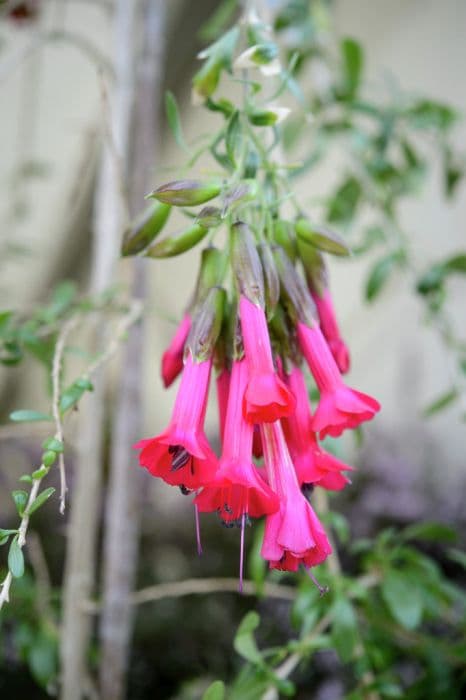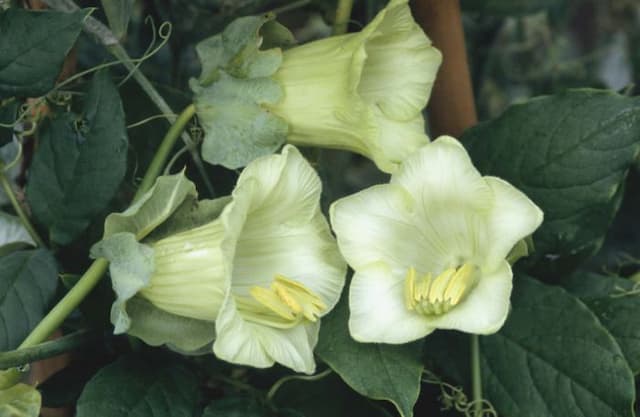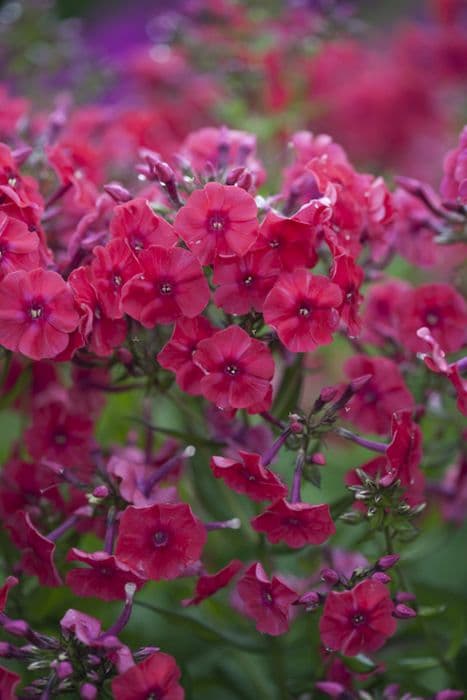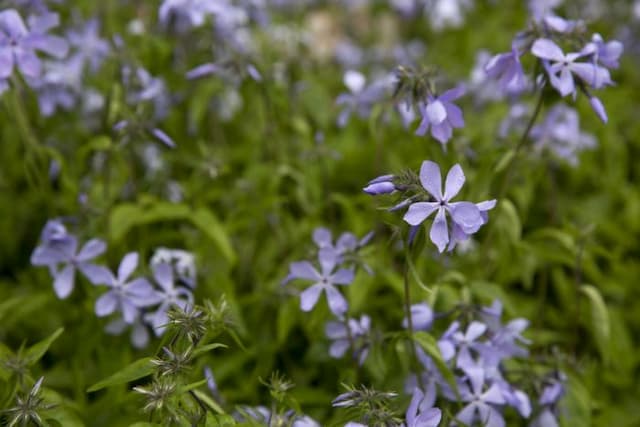Polemonium foliosissimum 'Scottish Garden'

ABOUT
The plant commonly referred to as 'Scottish Garden' is characterized by its lush, green foliage which is often finely divided, giving it a feathery appearance. The leaves can form a dense clump that provides a rich backdrop to its distinctive flowers. These blossoms are typically arranged in loose clusters at the end of delicate, upright stems. The flowers themselves boast an attractive form, usually bell-shaped that hang or stand with their faces upward, exhibiting a delightful array of colors that can include shades of blue, violet, or sometimes white. Each flower has a set of petals that are often rounded, contributing to its overall charming look. The 'Scottish Garden' variation provides an ornamental quality throughout its blooming season, which adds both color and texture to garden spaces.
About this plant
 Names
NamesFamily
Polemoniaceae.
Synonyms
Jacob's Ladder, Greek Valerian, Charity.
Common names
Polemonium foliosissimum.
 Toxicity
ToxicityTo humans
The Jacob's Ladder is known to be non-toxic to humans. It does not contain any known toxic compounds that would cause illness if ingested. Therefore, consuming parts of this plant typically does not lead to poisoning or adverse health effects.
To pets
Jacob's Ladder is generally considered non-toxic to pets as well. It should not cause any serious symptoms of poisoning if ingested by animals such as dogs or cats. However, ingestion of any plant material may cause mild gastrointestinal upset in some pets.
 Characteristics
CharacteristicsLife cycle
Perennials
Foliage type
Deciduous
Color of leaves
Green
Flower color
Blue
Height
1-2 feet (30-60 cm)
Spread
1 foot (30 cm)
Plant type
Herb
Hardiness zones
5
Native area
North America
Benefits
 General Benefits
General Benefits- Aesthetic Appeal: Adds delicate beauty to gardens with its clusters of bell-shaped flowers and fern-like foliage.
- Habitat for Wildlife: Attracts bees, butterflies, and other pollinators, enhancing biodiversity.
- Low Maintenance: Typically requires minimal care once established, making it suitable for gardeners of all skill levels.
- Cold Hardy: Able to withstand cooler temperatures, which is valuable for gardens in temperate regions.
- Shade Tolerant: Can thrive in partially shaded areas where other plants might struggle.
- Seasonal Interest: Offers visual interest throughout its blooming season, enriching the garden's overall display.
 Medical Properties
Medical PropertiesThis plant is not used for medical purposes.
 Air-purifying Qualities
Air-purifying QualitiesThis plant is not specifically known for air purifying qualities.
 Other Uses
Other Uses- Photography Enhancer: Photographers might use the striking blue flowers of the Jacob's Ladder as a natural backdrop to add depth and beauty to outdoor portraits and landscape photography.
- Educational Tool: Biology teachers may use the Jacob's Ladder in lessons about pollination or plant anatomy due to its distinct flower structure encouraging hands-on learning.
- Craft Material: The delicate foliage and flowers of Jacob's Ladder can be pressed and used in the creation of botanical prints or inclusions in handmade paper and bookmarks.
- Garden Design: This plant can be implemented in a themed garden dedicated to Scottish flora, thereby contributing to a garden's geographic or cultural storytelling.
- Color Dye: Though not commonly known, the petals of the Jacob's Ladder might be used to create a natural blue dye for fabrics, yarn, or in art projects.
- Religious Symbolism: In some cultures or contexts, the plant could be used to symbolize the biblical account of Jacob's Ladder as a reflection of reaching towards enlightenment or heaven, especially in themed gardens or religious educational settings.
- Labyrinth Gardens: Jacob's Ladder could be planted along the paths of labyrinth gardens to add visual interest and a sense of tranquility with their soft foliage and calming color.
- Phototropic Studies: As part of a science experiment, gardeners or students might observe the phototropic movement of the plant's flowers and leaves as they respond to the sun's position.
- Art Subjects: The intricate blossoms and ladder-like leaf arrangements of Jacob's Ladder make it an interesting subject for botanical illustrations and detailed watercolor paintings.
- Companion Planting: This plant might be used in companion planting strategies to provide visual interest and to attract pollinators which can benefit the surrounding garden plants.
Interesting Facts
 Feng Shui
Feng ShuiThe plant Jacob's Ladder is not used in Feng Shui practice.
 Zodiac Sign Compitability
Zodiac Sign CompitabilityThe plant Jacob's Ladder is not used in astrology practice.
 Plant Symbolism
Plant Symbolism- Humility - Because Polemonium, commonly known as Jacob's Ladder, is often found with its head bowed in a natural state, it can symbolize humility in literature and folklore.
- Connection - The ladder-like leaf structure of the Jacob's Ladder plant is reminiscent of the biblical ladder to heaven, symbolizing a connection to the divine or spiritual ascent.
- Solitude - Some traditions hold that Jacob's Ladder, because of its preference for isolated and cool environments, symbolizes the value of solitude and introspection.
 Water
WaterJacob's Ladder should be watered deeply, allowing the soil to become moist but not waterlogged. Typically, watering once a week during active growth periods should suffice, but always check the top inch of soil for dryness before adding more water. In a hotter climate or during the peak of summer, it may be necessary to increase the frequency to twice a week. Aim to use roughly one gallon of water per plant each time, ensuring even distribution around the root zone. Adjust the amount of water during the dormant season, reducing the frequency to once every two weeks or when the soil feels dry to the touch.
 Light
LightJacob's Ladder thrives in partial shade to full shade conditions, which makes it perfect for gardens with dappled sunlight or areas that receive morning sun and afternoon shade. An ideal spot for this plant would be under the canopy of tall trees where it can receive filtered light. Avoid placing it in full sun, as this can lead to leaf scorch and stress the plant.
 Temperature
TemperatureJacob's Ladder prefers a temperate climate with temperatures ranging between 45 to 75 degrees Fahrenheit. It can tolerate a minimum temperature of approximately 30 degrees Fahrenheit but should be protected from harsh, freezing conditions. The ideal temperature range ensures healthy growth and foliage development.
 Pruning
PruningPrune Jacob's Ladder to maintain shape, encourage bushier growth, and remove any spent flowers or damaged foliage. Light pruning can be done throughout the growing season as needed. The best time for a more thorough pruning is in the early spring or immediately after blooming to rejuvenate the plant and prepare it for the next growing cycle.
 Cleaning
CleaningAs needed
 Soil
SoilJacob's Ladder 'Scottish Garden' thrives in well-draining, fertile soil with a pH range of 6.0 to 7.5. A mix of loam, peat or compost, and sand or perlite is optimal to ensure good drainage and nutrient content. Mulching can help retain moisture and maintain soil conditions.
 Repotting
RepottingJacob's Ladder 'Scottish Garden' should be repotted every 2-3 years to replenish soil nutrients and to accommodate growth. Select a container with adequate drainage holes to prevent waterlogging.
 Humidity & Misting
Humidity & MistingJacob's Ladder 'Scottish Garden' prefers a moderate humidity level, similar to what it would experience in its natural woodland habitat. Aim for a humidity level between 40% and 60% for optimal growth.
 Suitable locations
Suitable locationsIndoor
Ensure bright, indirect light and regular watering for Jacob's Ladder.
Outdoor
Plant in partial shade, moist soil, and protect from harsh sun.
Hardiness zone
4-8 USDA
 Life cycle
Life cyclePolemonium foliosissimum 'Scottish Garden', also known as Jacob's Ladder, begins its life as a seed that germinates in spring when soil temperatures are suitable. After sprouting, the seedling grows into a rosette of pinnate leaves, establishing a root system before sending up a flower stalk. During late spring to early summer, the plant produces clusters of lavender to blue-violet flowers which are attractive to bees and other pollinators. Following pollination, the flowers develop into small capsules containing seeds that, once mature, are dispersed to begin a new generation. During the growing season, this perennial plant might experience several bloom cycles if conditions are favorable. In fall, the foliage typically dies back, with the roots remaining dormant over winter, ready to regrow the following spring.
 Propogation
PropogationPropogation time
Spring-Early Summer
Propogation: The most popular method of propagating Jacob’s Ladder (Polemonium foliosissimum 'Scottish Garden') is by division. This can be done in either spring or autumn, as the plants begin to emerge from dormancy or as they start to die back. To divide, carefully dig up the plant, ensuring to keep a good amount of root structure intact. The clump should then be gently pulled apart into smaller sections, each with at least one growing point. Replant the divisions immediately at the same soil depth they were previously growing and water them well. Providing a bit of shade can help prevent stress to the new plants until they establish. With consistent moisture and proper care, the divisions should take root and grow into healthy replicas of the parent plant.









